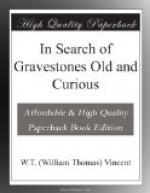It is obvious that the idea intended to be represented is figurative of death in infancy or childhood, and illustrates the well-known words of the Saviour, “Suffer little children to come unto me, and forbid them not: for of such is the kingdom of God,” quoted on the stone itself. In this and many similar cases in which the design and text are used for old or elderly people, they have been certainly strained from their true significance. The figure of a little child is, however, employed occasionally to represent the soul, and may also be taken to indicate the “new birth.”
There is an almost exact reproduction of the foregoing example in the same churchyard, even more remarkably at variance with Scriptural interpretation.
It is dedicated
“To John Clark, died 1793,
aged 62 years;
and Rebecca his wife, died 1794, aged 61
years.”
The inscription adds:
“What manner of persons these
were the last
day will discover.”
Gravestone plagiarism of this sort is very common, and there is to be found at West Ham, Essex, the same symbolical flight of the angel and child repeated as many as five times.
The pilfering is not so weak and lamentable when the copyist appropriates merely the idea and works it out in a new fashion. The term new can hardly be attributed to the notion of a plucked flower as a type of death, but it occurs in so many varieties as almost to redeem its conventionality.
The sculptor of a stone which is in Dartford burial-ground probably had the suggestion from a predecessor.
Fig. 7.—At Dartford.
“To James Terry, died 1755, aged 31 years.”
But not far from it in the same burial-ground, which is really a cemetery separated from the parish church, and one of the oldest cemeteries in England, is another imitation quite differently brought out, but in principle essentially the same.
Fig. 8.—At Dartford.
“To....Callow, died....1794....”
At the churchyard of Stone (or Greenhithe), two or three miles from Dartford, both these floral emblems are reproduced with strict fidelity.
This first chapter and the sketches which illustrate it will serve to introduce and explain my work and its scope.
In pursuing my investigations it was soon evident that the period of the allegorical gravestone was confined sharply and almost exclusively to the eighteenth century. I have seldom met one earlier than 1700, and those subsequent to 1800 are very rare. Of gravestones generally it may almost be said that specimens of seventeenth-century date are exceedingly few. There are reasons for this, as will afterwards appear. But the endurance even of the longest-lived of all the old memorials cannot be very much longer extended, and this may be my excuse for preserving and perpetuating the features of some of them as a not uninteresting




